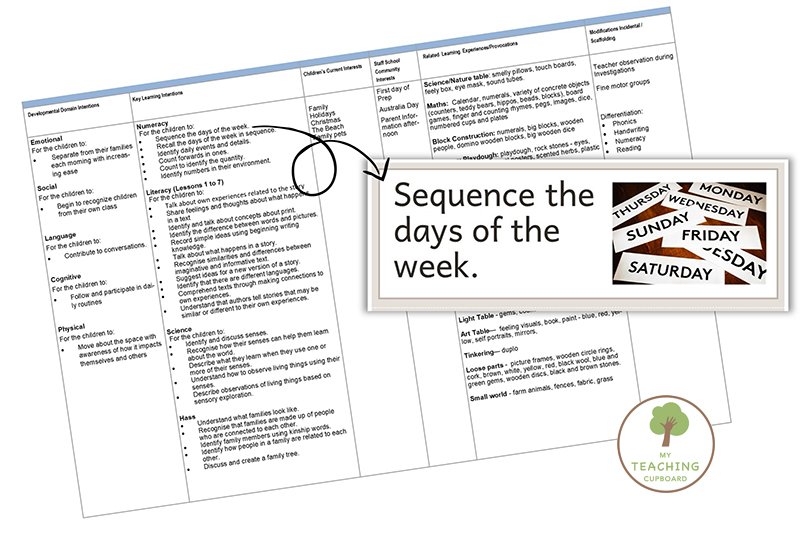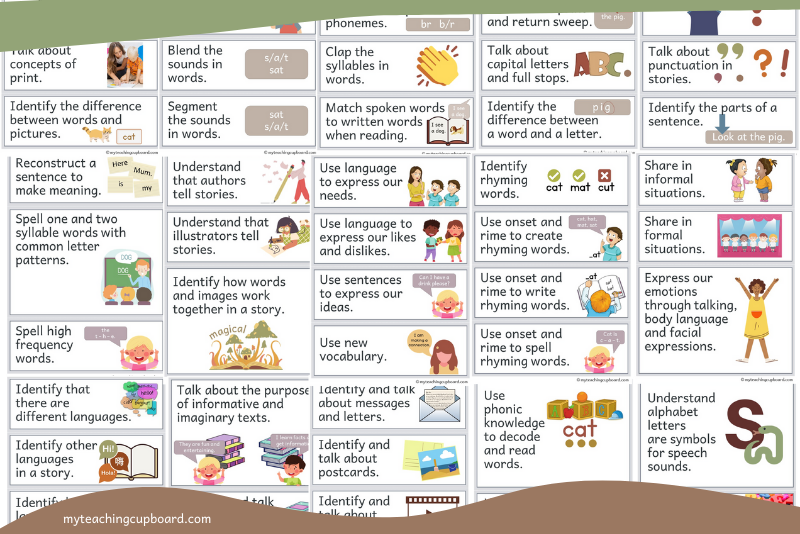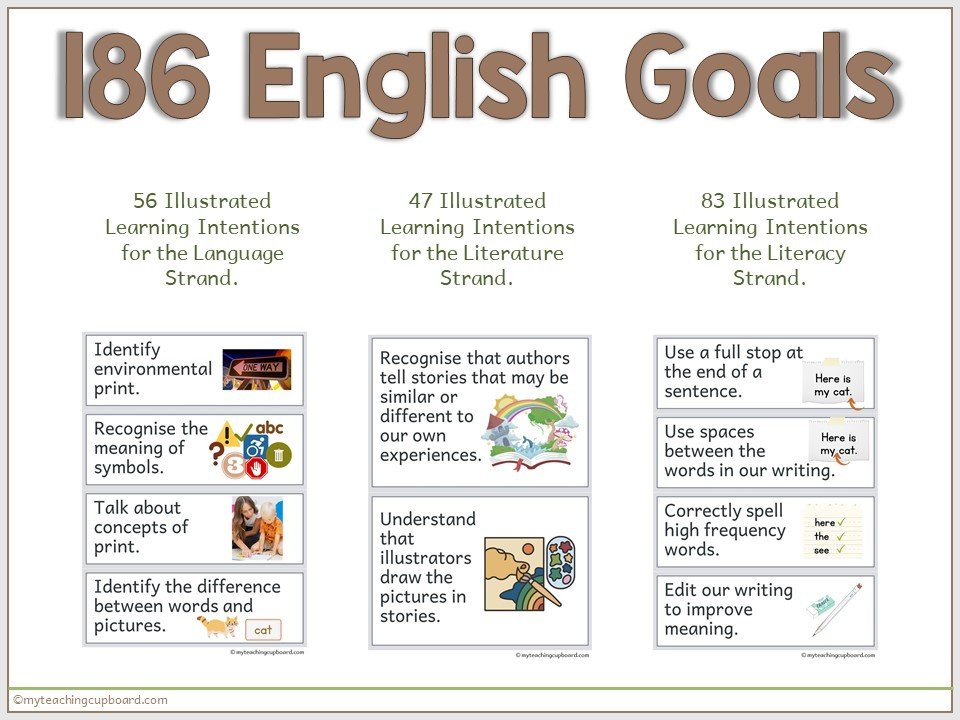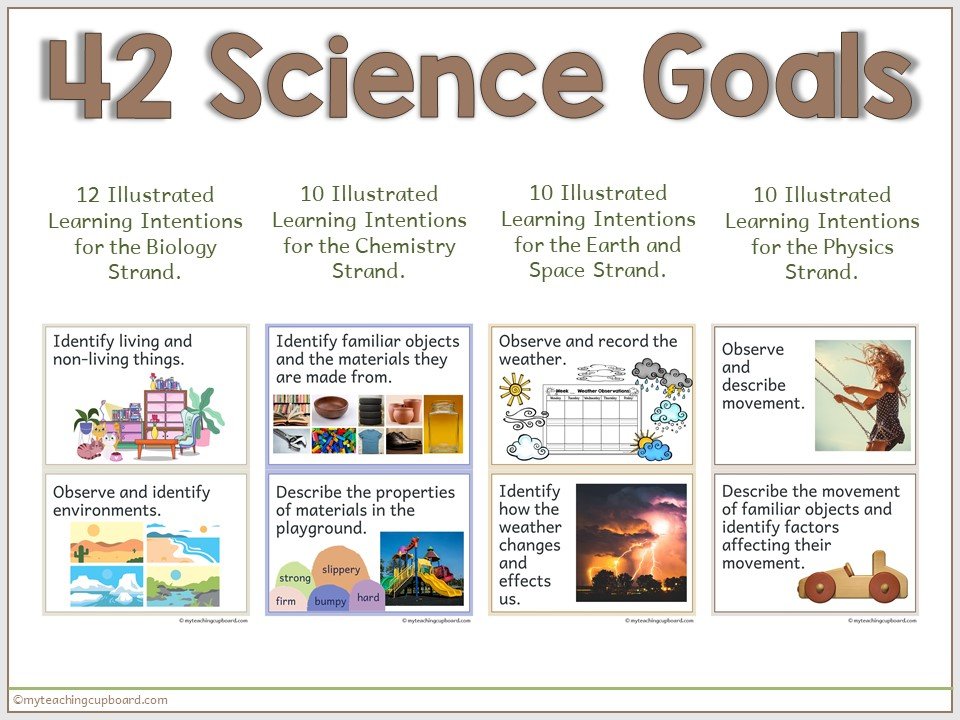How to Write Learning Intentions for Kindergarten and Preschool
Are you wondering how to write effective and age-appropriate learning intentions for your preschool or kindergarten classroom?
In this blog post you will discover some practical strategies to help you write curriculum aligned learning intentions your kindergarten and preschool children can relate to and use.
You might call learning intentions WALT goals, learning objectives or even curriculum outcomes. It does not matter what label you give to them. You can use the same process and strategies to write any of these.
I prefer to call them learning intentions because it places the emphasis on the process of our intended learning rather than a final product or piece of assessment.
Sometimes I call them WALT goals. WALT is an acronym for We Are Learning To. If you know about WALT goals, you will also be familiar with WILF (What I Am Looking For) and TIB (This Is Because).
I rarely refer to WLIF and TIB in my preschool or kindergarten classroom. I found the children just started tuning out whenever I mentioned them, so I avoid the WILF and TIB acronyms.
I am not suggesting you just abandon the WILF and TIB components. I certainly discuss the success criteria – What I Am Looking for and we regularly discuss the reasons we have particular learning intentions – This Is Because. These discussions are vital for optimal learning. I just don’t label the discussions with a WILF or TIB name.
Young children in preschool and kindergarten can become confused with acronyms. Most of these little learners are not confident readers or writers so the concept of an acronym is extremely foreign and irrelevant.
Purposeful discussions around learning intentions, success criteria and why we are learning the curriculum topics are very important however.
What is a Learning Intention?
Before we can write effective learning intentions, we need to know exactly what they are.
A learning intention in preschool and kindergarten needs to be a simple statement. The learning intentions you write for young children should be as short as possible and to the point.
An effective learning intention clearly describes what your children need to know, understand, and be able to do. The focus of a good learning intention should be on what your students are learning and not be about the lesson task or activity you have planned.
“Learning Intentions are what you want students to know and be able to do by the end of one or more lessons. Without learning intentions and success criteria, lessons wander and students become confused and frustrated.” Douglas Fisher and Nancy Frey
What are Success Criteria?
Success criteria and learning intentions go hand-in-hand.
Success criteria in the preschool and kindergarten classroom are the measures you use to determine whether, and how well, your little ones have met the learning intentions.
If you have designed the success criteria well, it should inform you and your children. With reference to the success criteria, you all should know if the set learning intentions have been achieved.
Success criteria should always be linked to your learning intentions and describe what success looks like.
Most early childhood teachers write the success criteria for their class but what if you and your children were to co-create the success criteria together?
Instead of just sharing teacher created success criteria with your children, try to involve them in creating it with you. Share the pen and co-create actual work samples together and use these as your success criteria. If you can co-create your class success criteria, your children will be much more likely to take ownership of their learning.
How Do You Write Learning Intentions?
Just like creating the success criteria, a lot of teachers think it is their job to write the class learning intentions too.
If you help your preschool and kindergarten children to create their own personalised learning intentions or learning goals, it can be very powerful. Personalised learning goals are so much more effective than teacher created ones.
You might like to check out this blog post: Personalised Writing Goals. In this blog post I explain how you can start setting personalised writing goals with the children in your class. Even the youngest beginner and pre-writers will benefit immensely from personalised learning intentions.
For effective learning to occur, we need to clearly communicate to our young learners what they are going to learn and why they should learn it in the first place. We also need to show them how they will recognise when they have mastered the learning intention.
It is important that the learning intentions and related success criteria link closely with the ACARA curriculum content descriptors and learning outcomes.
When writing learning intentions, it is important to consider if
they provide students with age-appropriate challenges.
they are matched to explicit teaching lessons.
they are matched to hands-on learning activities or learning invitations.
your children’s motivation to achieving them.
There’s a lot to consider. Writing a quality learning intention requires thoughtful planning. It’s worth the time and effort though. A good quality learning intention can help your children stay focused and on task.
Start with the Curriculum
Sometimes you will see an inspiring activity or investigation area on Pinterest or Instagram and want to implement it straight away in your classroom. This happens to me ALL the time!! In these situations, the learning intention unfortunately becomes an afterthought.
If you want to have successful and purposeful lessons and activities, your learning intentions need to be written first. Inspiring learning invitations from Instagram or Pinterest should not be your starting point. Start with your curriculum guides and your children’s abilities.
Your learning intentions need to be directly informed by the curriculum and your children’s developmental needs. After you write the learning intentions they will then influence and guide the related success criteria and learning activities.
If you would like more information on my process for how I use the ACARA and C2C curriculum guides to inform my planning and learning activities, you might be interested in my FREE Guide to Writing a Term Menu and Statement of Intent for play based learning. You can download it HERE in the FREE Resources Library.
Start with what you want your preschoolers and kindergarteners to know and why that is important. When you know that, you will find it much easier to write curriculum aligned learning intentions.
Then Determine the Success Criteria
We often use work samples as success criteria in the classroom. These samples of work can help children see what success looks like. They can also be used as teaching tools to help students assess their understanding.
I tend to use samples of work co-created with the children. Sometimes I might use the work samples of past kindergarten students. The C2C and ACRAA documents usually contain a modelled response and graded work samples which can often be used as success criteria too.
I avoid using any work samples from current students as success criteria. Nothing good can come from displaying graded students work and don’t get me started on bump it up walls!
Finally Create the Activity
Whether it is an explicit teaching lesson or a hands-on learning invitation, you will need to consider each investigation area you offer, every learning invitation you design and every lesson you teach after you have written your learning intentions.
Use Metalanguage and Build Vocabulary
As an early childhood teacher, you are probably quite proficient at writing learning intentions and success criteria in all of your planning documents. Sometimes we can run into a bit of difficulty when we try to re-write these documents into child-friendly terms.
When I first started sharing the curriculum learning intentions with my young learners, I thought I had to re-write them so that the children could understand them. This was so difficult and so many important concepts were lost in the translation. I quickly abandoned the idea of trying to re-write learning intentions using child friendly language.
I discovered preschool and kindergarten children are quite capable of learning and using new vocabulary and metalanguage. In fact, they loved all the new “adult” terms. It made them feel grown up.
As an early year’s teacher, you know how important vocabulary development and oral language are so just discuss and display the exact same learning intentions that are in your planning documents.
You will need to spend some time teaching the metalanguage and new terms of course, but you will be surprised how quickly and enthusiastically your children devour them.
Learning Intention Examples
Here is an example of how I developed the learning intentions for our Science Unit on Materials and their Properties.
I referred to the ACARA and C2C curriculum planning documents. I took the learning intentions directly from the ACARA content descriptors and C2C lesson objectives and evidence of learning.
I considered my current children’s interests and developmental needs and modified the learning intentions to suit.
I put each learning intention into a PowerPoint document and added appropriate pictures so that each learning intention had a visual cue the children could remember and relate to.
Kindergarten and preschool children are not confident with complex written language. The plain typed learning intentions I usually created and displayed in the classroom were not very effective because the children couldn’t even read them.
For this reason, I created visual prompts for each learning intention. The pictures helped the children remember the learning intention. I highly recommend using learning intentions with matching pictorial representations. They will help your beginning readers remember and better understand their WALT goals.
You can download a free set of illlustrated learning intentions HERE in the Free Resource Library. This is the complete set of learning intentions I made for the Science unit on Materials and their Properties. They will give you an idea on how to write illustrated learning intentions and also save you making a set for this unit.
If you are interested in more illustrated learning intentions for your classroom, you might be interested in my complete foundation stage set. I have made sets for all the English, Math, Science and HASS foundation stage curriculum.
It has taken me hours to design this full set of illustrated learning intentions. They are all aligned to our ACARA Foundation Stage curriculum.
All my hours of work paid off because now that I have them, the work is done and I can use them year after year. Each learning intention has been carefully linked to the Australian Curriculum English, Math, Science and HASS subjects. There are heaps more than I need but it is good to have a choice. You can check them out HERE.
Click the pic and save yourself hours of work with this huge bundle. I’ve done all the hard work for you. All of the learning intentions written and illustrated.
The pictures will act as a visual prompt and help your students remember and better understand all of their WALT goals.
THIS SET CONTAINS ENGLISH OBJECTIVES & BANNERS:
56 visual WALT goals or Learning Intentions for the Language strand
47 visual WALT goals or Learning Intentions for the Literature strand
83 visual WALT goals or Learning Intentions for the Literacy strand
Content strand headings
WALT banner
English headings
AND THIS SET CONTAINS MATH OBJECTIVES & BANNERS:
81 visual WALT goals or Learning Intentions for the Number and Algebra strand
71 visual WALT goals or Learning Intentions for the Measurement strand
7 visual WALT goals or Learning Intentions for the Statistics and Probability strand
Content strand headings
WALT banner
Math headings
THIS SET CONTAINS SCIENCE OBJECTIVES & BANNERS:
12 visual WALT goals or Learning Intentions for the Living Things Unit
10 visual WALT goals or Learning Intentions for the Materials and their Properties Unit
10 visual WALT goals or Learning Intentions for the Weather Unit
10 visual WALT goals or Learning Intentions for the How Things Move Unit
Content strand headings
WALT banner
Science Unit
AND THIS SET CONTAINS HASS OBJECTIVES & BANNERS TOO:
11 visual WALT goals or Learning Intentions for the History strand
11 visual WALT goals or Learning Intentions for the Geography strand
WALT banner
HASS Unit headings
These effective and thoughtfully aligned ACARA learning intentions will improve your student’s learning because research indicates that students who regularly discuss and are made aware of their learning intentions are more
focused and for longer periods of time.
more motivated and active in their learning.
able to take responsibility for their own learning.
You will receive a total of 409 illustrated learning intentions aligned to the ACARA Foundation Stage curriculum and when you use them in your classroom, you will be giving your children the tools they need to take more responsibility for their own learning and achieve greater learning independence.
Now you know my process for writing effective and age-appropriate learning intentions. I hope you can use these strategies to help you write curriculum aligned learning intentions your children can actually relate to and use.
If you liked this post on writing learning intentions for preschool and kindergarten, please consider sharing it...
Just CLICK the sharing box below.👇























